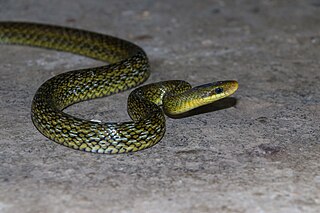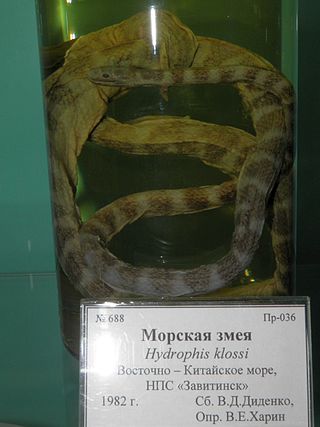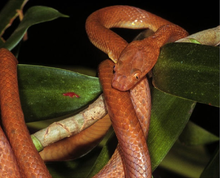
Paroedura is a genus of geckos, endemic to Madagascar and the Comoros. These geckos are typically terrestrial, though the young of most species can climb until they are too heavy for their feet to support.

Calumma is a genus of chameleon endemic to the island of Madagascar. One species, formerly known as Calumma tigris, was transferred to the genus Archaius in 2010, upon the discovery of its closer relation to Rieppeleon—one of several genera referred to collectively as "leaf" or "pygmy" chameleons—rather than to Calumma. The earliest known fossil of the genus is of Calumma benovskyi, from early Miocene Kenya, showing that the genus likely originated on mainland East Africa. The genus includes one of the heaviest and longest chameleon species, the Parson's chameleon.

Craspedocephalus macrolepis, commonly known as the large-scaled pit viper, is a venomous pitviper species endemic to the Southern Western Ghats of South India. No subspecies are currently recognized.

Elaphe hodgsoni, the Hodgson's rat snake, is a species of snake in the family Colubridae. The species is found in parts of Asia around the Himalayas.

Hydrophis klossi, commonly known as Kloss's sea snake, is a species of sea snake in the family Elapidae. Like all other sea snakes, it is venomous. The species is endemic to the Indian Ocean.

Hydrophis melanocephalus, commonly known as the slender-necked sea snake, is a species of venomous sea snake in the family Elapidae.

Günther's black snake is a species of poorly known lamprophiid snake endemic to central Africa. It is the only member of the genus, Bothrolycus. This snake is notable as one of the few snakes with notable sexual dimorphism, as well as possessing a small pit anterior to the eye. While superficially similar to the thermal pits of vipers, its function remains unknown.

Elapotinus is a monotypic genus created for the rear-fanged snake species, Elapotinus picteti. The species is endemic to Madagascar. It is also known commonly as Jan's snake in honor of Italian herpetologist Giorgio Jan. There are no subspecies that are recognized as being valid.

Macrelaps is a monotypic genus created for the rear-fanged (opisthoglyphous) venomous snake species, M. microlepidotus, endemic to South Africa. No subspecies are currently recognised.

The Pseudoxyrhophiidae is a family of elapoid snakes, found mostly in Madagascar. They were formerly placed as a subfamily of the Lamprophiidae, but have been more recently identified as a distinct family.

Atractaspis aterrima, commonly known as the slender burrowing asp or mole viper, is a species of fossorial, venomous snake in the family Atractaspididae. The specific epithet, aterrima, meaning "blackest", is the superlative form of the Latin adjective ater, meaning "black".

Xenocalamus bicolor, also known commonly as the bicoloured quill-snouted snake and the slender quill-snouted snake, is a species of mildly venomous rear-fanged snake in the family Atractaspididae. The species is endemic to Africa. Four subspecies are recognized as being valid.
The Jampea Island pipe snake is a species of snake in the Cylindrophiidae family endemic to Tanah Jampea, Indonesia. The specific epithet, isolepis, meaning "equal scale", refers to the fact that in this species, the ventral scales are the same as the dorsal scales.

Amblyodipsas microphthalma, also known as the eastern purple-glossed snake or white-lipped snake, is a species of mildly venomous rear-fanged snake in the Atractaspididae family.

Aparallactus modestus, or the western forest centipede-eater, is a species of mildly venomous rear-fanged snake in the Atractaspididae family.

Liophidium is a genus of snakes in the family Pseudoxyrhophiidae. The genus contains ten species, nine of which are endemic to the island of Madagascar and one to the island of Mayotte. All species of Liophidium are harmless to humans.
Phisalixella is a genus of pseudoxyrhophiid snakes endemic to the island of Madagascar. They are harmless to humans.

Compsophis is a genus of harmless snakes in the family Pseudoxyrhophiidae. The genus is found only on the island of Madagascar.

Lycodryas maculatus, also known commonly as the spotted tree snake, is a species of snake in the family Pseudoxyrhophiidae. The species is endemic to the Comoros. It is harmless to humans.



















